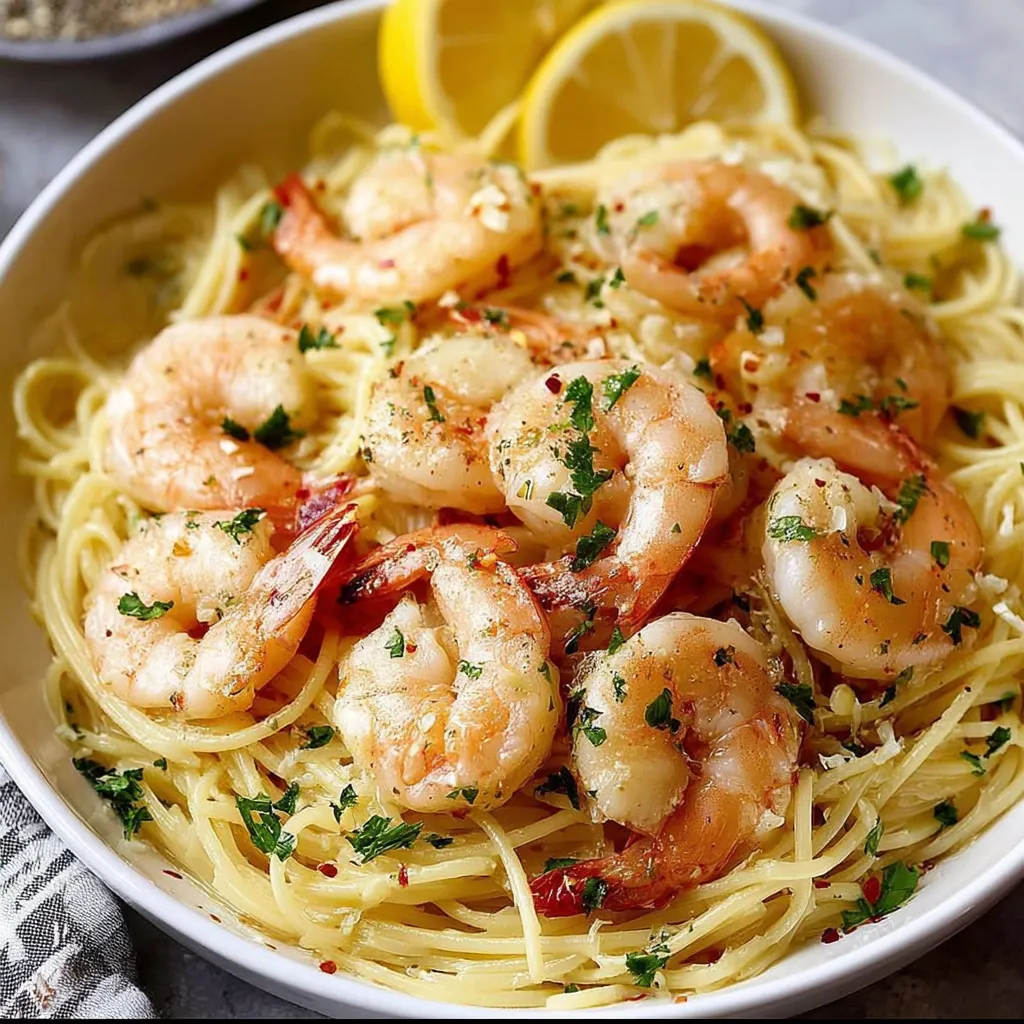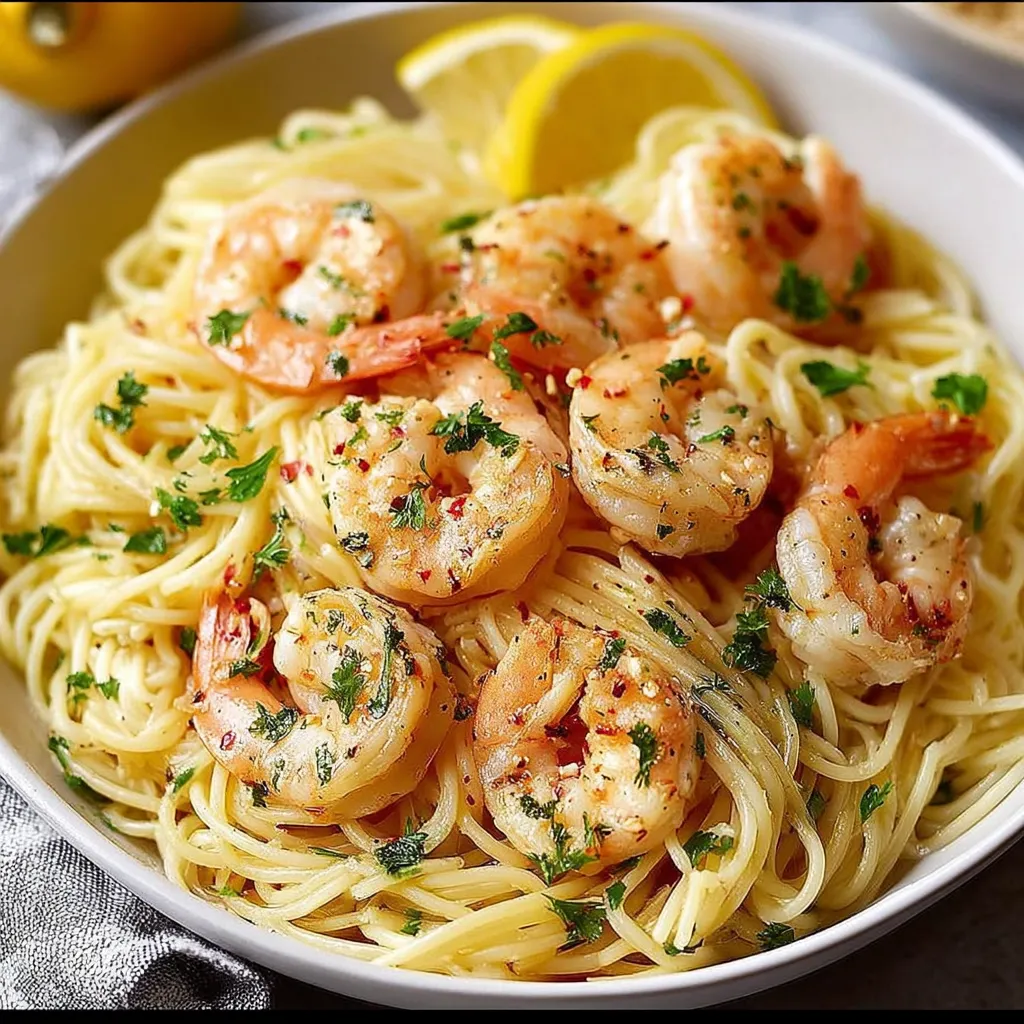 Save
Save
This classic shrimp scampi combines succulent seafood with a garlicky, buttery sauce that coats each strand of pasta perfectly. It's the dish I turn to when I want to impress dinner guests without spending hours in the kitchen.
I first made this recipe when trying to recreate my favorite Italian restaurant dish at home. After a few attempts tweaking the sauce proportions, my family now requests this more than the restaurant version.
Ingredients
- Large shrimp: peeled and deveined, look for wild caught when possible for best flavor
- Linguine or spaghetti: provides the perfect texture to hold the delicate sauce
- Unsalted butter: creates the rich base of the sauce without overwhelming saltiness
- Olive oil: prevents the butter from burning and adds fruity notes
- Fresh garlic cloves: the soul of scampi, always use fresh not jarred
- Red pepper flakes: adds a subtle heat that balances the richness
- Dry white wine: provides acidity and depth, Sauvignon Blanc or Pinot Grigio work beautifully
- Fresh lemon juice: brightens the entire dish, never use bottled
- Fresh parsley: adds color and a fresh herbaceous finish
Step-by-Step Instructions
- Cook the pasta:
- Bring a large pot of heavily salted water to a rolling boil. Add pasta and cook until al dente according to package directions, usually 8 to 10 minutes. Reserve 1/4 cup pasta water before draining in case you need to loosen the sauce later.
- Prepare the garlic butter base:
- Melt 2 tablespoons butter with olive oil in a large skillet over medium heat until the butter stops foaming. Add minced garlic and red pepper flakes and cook for exactly 60 seconds until fragrant but not browned. Garlic burns quickly so watch carefully.
- Cook the shrimp:
- Add shrimp to the skillet in a single layer ensuring they don't overlap. Season generously with salt and freshly cracked black pepper. Cook until they just turn pink, about 1 to 2 minutes per side. They should form a slight C shape when perfectly cooked. Remove to a plate to prevent overcooking.
- Create the sauce:
- Pour white wine into the empty skillet and use a wooden spoon to scrape up all the flavorful browned bits from the bottom. Let the wine simmer and reduce by half, about 2 to 3 minutes, which concentrates the flavor and cooks off the alcohol.
- Finish the sauce:
- Add fresh lemon juice and remaining tablespoon of butter to the reduced wine. Swirl the pan as the butter melts to create a silky emulsified sauce. This technique creates a velvety texture without separating.
- Combine everything:
- Return the shrimp to the skillet along with any accumulated juices. Add the drained pasta and fresh parsley. Gently toss everything together using tongs until the pasta is evenly coated with sauce and the shrimp are distributed throughout.
The quality of your shrimp makes all the difference in this dish. I discovered this when I splurged on fresh shrimp from our local fishmonger instead of using frozen. The sweet oceanic flavor was incomparable and transformed this simple recipe into something truly special.
Perfect Wine Pairing
Shrimp scampi calls for a crisp white wine that complements its buttery garlic flavors. The same wine you use in cooking makes an excellent pairing. I prefer a bright Pinot Grigio or unoaked Chardonnay that won't overpower the delicate shrimp. The wine's acidity cuts through the richness of the butter sauce while enhancing the lemon notes.
Make It Ahead
While shrimp scampi is best enjoyed immediately after cooking, you can prep ingredients ahead of time. Peel and devein shrimp, mince garlic, chop parsley, and measure remaining ingredients up to 24 hours in advance. Store everything separately in the refrigerator. When ready to cook, the entire dish comes together in minutes. This preparation strategy has saved me countless times when hosting dinner parties.
Customize Your Scampi
This versatile recipe welcomes thoughtful additions. For extra vegetables, try adding halved cherry tomatoes during the final minute of cooking to warm through without breaking down. Thinly sliced zucchini can be sautéed with the garlic. For a richer version, finish with a splash of heavy cream or sprinkle of freshly grated Parmesan. My personal favorite variation includes a handful of baby spinach added just before serving, wilting naturally from the heat of the pasta.

Recipe FAQs
- → Can I substitute the white wine in shrimp scampi?
Yes, you can easily substitute the white wine with chicken broth for an alcohol-free version. You could also use vegetable broth or even a combination of broth with a tablespoon of lemon juice for extra acidity that mimics the wine's flavor profile.
- → How do I know when the shrimp are perfectly cooked?
Shrimp cook very quickly and are done when they turn from translucent gray to opaque pink and form a C-shape. This typically takes just 1-2 minutes per side. Be careful not to overcook them, as they can become tough and rubbery. They should be tender and slightly firm to the touch.
- → What can I serve with shrimp scampi?
Shrimp scampi pairs wonderfully with crusty bread for soaking up the delicious sauce. A simple green salad with a light vinaigrette makes a perfect side, as does steamed asparagus or broccoli. For a lighter meal, you could even serve the shrimp and sauce over zucchini noodles instead of pasta.
- → Can I make this dish ahead of time?
While shrimp scampi is best enjoyed immediately after cooking, you can prepare components ahead of time. Clean and devein the shrimp, mince the garlic, and chop the parsley up to a day in advance. The actual cooking process is quick, so it's best to toss the pasta with the sauce and shrimp just before serving for the optimal texture and flavor.
- → How do I properly devein shrimp?
To devein shrimp, use a small paring knife to make a shallow cut along the back of the shrimp, exposing the dark intestinal tract. Lift it out with the tip of your knife and discard. You can leave the tails on for presentation or remove them for easier eating. Many stores sell shrimp that are already peeled and deveined to save time.
- → What type of white wine works best in this dish?
A dry, crisp white wine like Pinot Grigio, Sauvignon Blanc, or unoaked Chardonnay works best. Choose a wine you'd enjoy drinking, as the flavor will concentrate in the sauce. Avoid sweet wines, which can make the dish too sweet, or cooking wines, which often contain salt and additives that might affect the flavor.
